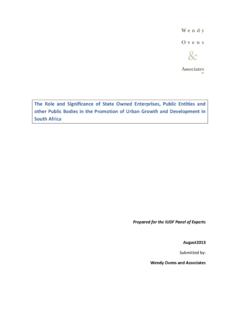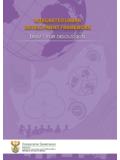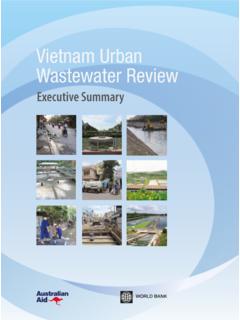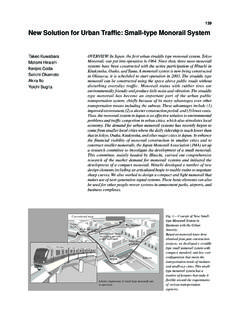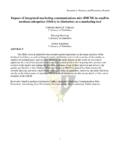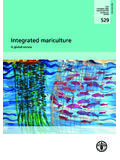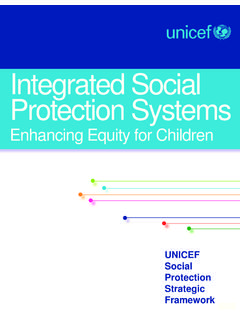Transcription of Integrated livestock-fish farming systems
1 Integrated livestock -fishfarming systemsIntegrated livestock -fishfarming systemsIntegrated livestock -fishfarming LITTLE ANDP. EDWARDSINLAND WATER RESOURCES AND AQUACULTURE SERVICEANIMAL PRODUCTION SERVICEFOOD AND AGRICULTURE ORGANIZATION OF THE UNITED NATIONSROME 2003 All rights reserved. Reproduction and dissemination of material in this information product for educational or other non-com-mercial purposes are authorized without any prior written permission from the copyright holders provided the source is fullyacknowledged. Reproduction of material in this information product for resale or other commercial purposes is prohibited with-out written permission of the copyright holders. Applications for such permission should be addressed to the Chief, PublishingManagement Service, Information Division, FAO, Viale delle Terme di Caracalla, 00100 Rome, Italy or by e-mail to FAO 2003 The designations employed and the presentation of material in this informationproduct do not imply the expression of any opinion whatsoever on the part ofthe Food and Agriculture Organization of the United Nations concerning thelegal or development status of any country, territory, city or area or of itsauthorities, or concerning the delimitation of its frontiers or of this documentThis book was preparedby the authors under the overallcoordination of Matthias Halwart, Fishery Resources Officer (Aquaculture)
2 And with the collaboration of colleagues from Animal Production Service,particularly Manuel Sanchez and Simon Mack, who contributed printing of the publication was supported by the InterdepartmentalWorking Group on Integrated Production systems . Graphic design byJoanne Morgante. All photos by 92-5-105055-4 iiiPrefaceSmall farmers in developing countriesare poorer thanthe rest of the population, often not getting enough food to lead normal, healthyand active lives. Dealing with poverty and hunger in much of the world thereforemeans confronting the problems that small farmers and their families face intheir daily struggle for survival. One option for economically and ecologicallysustainable development of farming systems is the integration of agricultureand aquaculture. The various types of aquaculture form a critical component withinagricultural and farming systems development that can contribute to thealleviation of food insecurity, malnutrition and poverty through the provision offood of high nutritional value, income and employment generation, decreasedrisk of production, improved access to water, sustainable resource managementand increased farm sustainability.
3 livestock production and processing generate by-products that may beimportant inputs for aquaculture. The main linkages between livestock and fishproduction involve the direct use of livestock wastes, as well as the recycling ofmanure-based nutrients which function as fertilizers to stimulate natural a global basis, most cultured freshwater fish are produced in Asia insemi-intensive systems that depend on livestock wastes purposely used inponds, or draining into them. Much of the vast increase in China s recent inlandaquaculture production is linked to organic fertilization, provided by the equallydramatic growth of poultry and pig production. The use of livestock wastes isstill needed, even when high-quality supplementary feeds are available and theyare still widely used in more intensive aquaculture objective of the publication is to provide an analysis of the evolutionand current status of Integrated livestock - fish systems in Asia, particularly Eastand Southeast Asia, as well as to provide a sound technical basis for consideringtheir relevance for the planning of livestock - fish systems in Africa and is hoped that the conclusions and recommendations presented here willbe interesting and thought-provoking for a wide audience generally interestedin the subject of Integrated agriculture-aquaculture, and particularly policymakers, planners, NGOs and senior research and extension staff.
4 It is hoped thatthe book will stimulate these people at all levels to ensure that agriculturaldevelopment provides for reasonable rural livelihoods, a clean environment, andadequate food Jia - Chief, Inland Water Resources and Aquaculture ServiceIrene Hoffmann - Chief, Animal Production Rationale of the Definitions of Integrated Potential Linkages Between livestock and fish Production Relevance of Integrated farming Sustainability Issues at Micro- and Development of Integrated livestock - fish farming systems in systems and Environmental Crop Integrated Industrial Monoculture213 Major Types of Integrated systems in Current Upgrading Traditional livestock systems for Aquaculture livestock DIETS AND PRODUCTION OF MONOGASTRIC WASTES IN SMALL-HOLDER INPUT Integration with CONSIDERATIONS404 Environmental Nutrients RECYCLING IN EFFICIENCY IN EFFICIENCY IN RELATIONSHIPS IN livestock - fish SYSTEMS53ivINTEGRATED livestock - fish farming Significance of livestock and fish Production in the Global OF FISHERIES TO SUPPORT livestock AND fish OF livestock systems ON fish PRODUCTION585
5 Design Criteria for livestock Manured Ponds Manured Pond OF OF SUPPLEMENTARY Waste , SIZE AND AND WASTE RELEASE FROM COLLECTION AND Waste Addition796 Public Health and General BACTERIA AND INSECT-VECTOR BORNE INFLUENZA Chemical Hazards and Associated Biological Summary1007 Social and Economic Nutritional Gender and Resource Promotion of Integrated HUMAN FACTORS1298 Transferability of Asian Experiences to Africa and Latin General Information Institutional Seed Theft and Multipurpose Use and Comparing the Regions1439 Future Directions in livestock - fish Demand and Feed Intensification not Peri-Urban Rural Potential156 Acknowledgements159 References161viINTEGRATED livestock - fish farming SYSTEMS89 List of TablesTable the integration of fish culture into small-holder crop/ livestock systems affects assetaccumulation and livelihoodsTable livestock and fish improve the sustainability of farming systemsTable of common
6 Property management and scope for intensification in water-scarce andflood-prone environmentsTable of livestock waste qualities and suitability for use in aquacultureTable in frequency of pond inputs before and after extension in Kapsia Thana, Gazipur District,BangladeshTable of the use of wastes from ducks fed supplements to scavenging, in addition to inorganicfertilisation, on overall system feed efficiency and and fertilizer inputs in Integrated systems for three areas with different levels of productionin ChinaTable comparison of different fertilizers with respect to available nitrogen (N),phosphorous (P)and carbon (C).Table of N recovery in ponds stocked with Nile tilapia and fertilised with livestock wasteTable consumption of fish production integrate with livestock or as a stand-alone enterpriseTable and constraints to integration of livestock with fish by systemTable affecting use of animal wastes in pondsTable and output of poultry waste fed-aquacultureTable of feeding and management on waste characteristics of livestockTable types of parasitesTable hazards and associated risks to fish productionTable of livestock wastes and other inputs in fish culture in NE ThailandTable inventories and fertilisers used in an on-farm trial with farmers in Udorn Thani, NortheastThailandTable of pig production in three areas of Southeast AsiaTable that reduce smallholders' risk through production of livestock , fish or Issues and problems from the perspective of aquaculture promoters in Africa.
7 Latin America andAsiaTable to intensify livestock and fish production without spatial concentrationTable of multipurpose use of a water body involving livestock and fish productionList of BoxesBOX of key issues affecting linkages between livestock and fish productionBOX widely used definition of sustainabilityBOX definedBOX view of sustainabilityBOX to sustainable farming in the Red River Delta, Viet NamBOX decline in Integrated farming in China?BOX constrains livestock productionBOX of ruminant and macrophagous fish have similar constraintsBOX study of Integrated farming in Central ThailandviiviiiINTEGRATED livestock fish farming SYSTEMSBOX to integration of traditional livestock and fish productionBOX indicators of the potential for upgradingBOX scavenging poultry diets and management in EthiopiaBOX Integrated systems in ChinaBOX of factors affecting use of inorganic fertilizer and feeds with livestock wastesBOX from livestock and processing wasteBOX blowfly larvae used to process pig manure to fish feedBOX slaughter house waste fed to catfishBOX maize to catfishBOX flows among village subsystems and between village and outside systems in Nguyen Xavillage.
8 Viet NamBOX to reducing livestock wastes and environmental pollutionBOX of nutrients and the environmentBOX need for water encourages Integrated fish cultureBOX of factors through which livestock and fish interact with the global environmentBOX of animal manures in pond cultureBOX fertilization rates defined by experimentationBOX loadings of ruminant manureBOX of supplementary feedingBOX results with supplementary feedingBOX of key factors affecting manured pond dynamicsBOX management level affects nutrients collectable for aquacultureBOX of supplementary feed affects scavenging poultry wastes and fish productionBOX of duck and fish production in ricefields in the PhilippinesBOX of supplementary feed quality on waste characteristicsBOX of factors affecting livestock waste characteristicsBOX 's duck slaughterhouse in Bang Lane, Central ThailandBOX 's use of duck manure in Nakon Pathum, ThailandBOX affecting characteristics of livestock waste and its use for aquacultureBOX to ask during the design of livestock - fish systemsBOX points to reducing public health risks from pathogens in livestock - fish systemsBOX issues as aquaculture stimulates changes in household pig production in Lao PDRBOX points to reducing public health risk due to parasites and other biological and chemical agentsBOX of key points relating to social and economic issuesBOX social assetsBOX quality control hinders export of value-added fish productsBOX of demand related issuesBOX Nutritional importance of fishBOX and benefits from aquacultureBOX women in aquacultureBOX relationships affect production and consumptionBOX of key points relating to role of gender in Integrated aquacultureBOX constraints to using livestock waste in Northeast ThailandBOX rice land holding.
9 Rice yield and pig productionBOX maize enhances Integrated approachBOX the village pig herd in a village in Northeast Thailand-potential impacts on fishproductionBOX Summary of key resource issuesBOX of livestock - fish systems in AsiaBOX of Integrated livestock - fish production in the provinces around Bangkok, ThailandBOX "Top down" small-scale duck- fish integration failsBOX approach to understanding constraints to fish production in rain-fed cascade tank systems inthe Dry Zone, Sri in aquaculture development to serve local demandBOX targeted research for resource-poor farmersBOX issues constraining aquaculture development common to Asia, Africa and LatinAmericaBOX to fish seed production in AfricaBOX self-sufficiency of fish seedBOX happens to famed fish in rural Africa, Latin America and Asia?BOX affecting the success of Integrated livestock aquaculture in community managed waterbodies in Northeast Thailand and Lao PDRBOX community-level aquaculture in PanamaBOX failed attempt at community aquaculture in NigeriaBOX influencing the relatively lower success of rural aquaculture in Africa and Latin Americathan AsiaBOX policies to discourage concentration of intensive livestock and fish productionBOX phases out pig productionBOX of solid and liquid fractions improves the efficiency of livestock waste use in farmingsystemsBOX opportunities for smallholders to integrate egg-duck and fish productionBOX efficiency of traditional, upgraded and modern livestock systemsBOX pigs on small fishList of FiguresFigure 1: The development of sustainable aquaculture systems involves consideration of productiontechnology, social and economic aspects, and environmental aspects (Source: AIT, 1994).
10 Figure 2: Potential outcomes of livestock - fish integrationFigure 3: Main and secondary linkages in livestock - fish integrationFigure 4:Asset pentagons to analyse sustainable rural livelihoodsFigure 5: Evolutionary development of Integrated farming systemsFigure 6: Classification of livestock production and relationship to value of livestock waste for aquacultureFigure 7: Percentage of farms using various fertilizer and supplementary feed inputs for fish culture inCentral Thailand (a) manure (b) rice and grain products (c) waste food from human consumptionand agro-industry (d) animal by-products and animal feed (e) vegetable matterFigure 8: livestock present and Integrated on fish farms in Central Thailand by type and number of livestock Figure 9: Percentage yield by fish species in three areas of productivity in ChinaFigure 10: Comparison of possible strategies for using livestock production and processing wastes inaquacultureFigure 11: Percentage of farms in Central Thailand using various fertiliser and supplementary feed inputs forfish culture (a) waste food from human consumption and agro-industry (b) animal by-products andanimal feed (c) vegetable matter Figure 12: The two-way interaction between aquaculture and the environment involves numerous factorsthat range from positive to negative in their impactixxINTEGRATED livestock - fish farming SYSTEMSF igure 13: Nutrient cycles for an agro-ecosystem involving crops, fish and livestockFigure 14: Nutrient flows among village subsystems and between village and outside systemsFigure 15: Mean dissolved oxygen (DO) in mg I-1at dawn for ponds receiving different levels of ma










